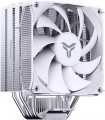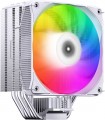Max. TDP
The maximum TDP provided by the cooling system. Note that this parameter is indicated only for solutions equipped with heatsinks (see "Type"); for separately made fans, the efficiency is determined by other parameters, primarily by the air flow values (see above).
TDP can be described as the amount of heat that a cooling system is able to remove from a serviced component. Accordingly, for the normal operation of the entire system, it is necessary that the TDP of the cooling system is not lower than the heat dissipation of this component (heat dissipation data is usually indicated in the detailed characteristics of the components). And it is best to select coolers with a power margin of at least 20 – 25% — this will give an additional guarantee in case of forced operation modes and emergency situations (including clogging of the case and reduced air exchange efficiency).
As for specific numbers, the most modest modern cooling systems provide TDP
up to 100 W, the most advanced —
up to 250 W and even
higher.
Heat pipes
Number of heat pipes in the cooling system
The heat pipe is a hermetically sealed structure containing a low-boiling liquid. When one end of the tube is heated, this liquid evaporates and condenses at the other end, thus removing heat from the heating source and transferring it to the cooler. Nowadays, such devices are widely used mainly in processor cooling systems (see "Intended use") — they connect the substrate that is in direct contact with the CPU and the heatsink of the active cooler. Manufacturers select the number of tubes based on the overall performance of the cooler (see "Maximum TDP"); however, models with similar TDPs can still differ markedly in this parameter. In such cases, it is worth considering the following: increasing the number of heat pipes increases the efficiency of heat transfer, but also increases the dimensions, weight and cost of the entire structure.
As for the number, the simplest models provide
1 – 2 heat pipes, and in the most advanced and powerful processor systems, this number can be
7 or more.
Lighting
The presence
of its own illumination in the design of the cooling system.
The backlight serves a purely aesthetic function — it gives the device a stylish appearance that blends well with other components in the original design. Thanks to this, such cooling systems are especially appreciated by gamers and fans of external PC modding — especially since the lighting can be different, and the most advanced models even provide backlight synchronization with other components (see below). On the other hand, this function does not affect the efficiency and performance, and the overall cost is inevitably affected, sometimes quite noticeably. Therefore, if the appearance does not play a fundamental role for you, the best choice, most likely, will be
a cooling system without backlight.
Lighting colour
The colour of the backlight installed in the cooling system.
See above for more details on the backlight itself. Also note here that in the illumination of modern cooling systems there is both one colour (most often
red or
blue, less often
green,
yellow,
white or
purple), and multi-colour systems such as
RGB and
ARGB. The choice of a single-colour backlight depends mainly on aesthetic preferences, but the last two varieties should be touched upon separately.
The basic principle of operation of both RGB and ARGB systems is the same: the design provides for a set of LEDs of three basic colours — red (Red), green (Green) and blue (Blue), and by changing the number and brightness of the included LEDs, you can not only intensity, but and tint of light. The difference between these options differs in functionality: RGB systems support a limited set of colours (usually up to one and a half dozen, or even less), while ARGB allows you to choose almost any shade from the entire available colour range. At the same time, both of them can support backlight synchronization (see below); in general, this function is not required for RGB and ARGB systems, but it is used almost exclusively in them.
Lighting sync
Backlight synchronization technology, provided in the cooling system with built-in lighting (see above).
Synchronization itself allows you to "match" the cooling backlight with the backlight of other system components — the motherboard, processor, graphics card, case, keyboard, mouse, etc. Thanks to this matching, all components can change colour synchronously, turn on / off at the same time, etc. The specific features of the operation of such a backlight depend on the synchronization technology used, and, usually, each manufacturer has its own (Aura Sync for Asus, RGB Fusion for Gigabyte, etc.). The compatibility of the components also depends on this: they must all support the same technology. So the easiest way to achieve backlight compatibility is to collect components from the same manufacturer. However, among the cooling systems there are solutions of the multi compatibility format — compatible with several synchronization technologies at once; a specific compatibility list is usually indicated in the detailed specifications of such models.
Mount type
—
Latches. The simplest and most convenient type of fastening, in particular due to the fact that it does not require the use of additional tools. Plus, you don't need to remove the motherboard for snap-on installation.
— Double-
sided (backplate). This type of fastening is used in the most powerful and, as a result, heavy and large-sized cooling systems. Its feature is the presence of a plate installed on the opposite side of the motherboard — this plate is designed to protect against damage and so that the board does not bend under the weight of the structure.
—
Bolts. Fastening with classic bolts. It is considered somewhat more reliable than latches (see above), but less convenient, because. You can remove and install the cooling system only with a screwdriver. To date, bolts are mainly used to fasten case fans, as well as cooling systems for RAM and hard drives (see "Type", "Purpose").
—
Silicone mounts. The main advantage of silicone fasteners is good vibration absorption, which significantly reduces the noise level compared to similar systems using other types of fasteners. On the other hand, silicone is somewhat less reliable than bolts, so both types of fasteners are usually supplied in the kit, and the user chooses which ones to use.
— Adhesive tape. Fastening with adhesive tape (adhesi
...ve tape), usually double-sided. The main advantages of this mount are ease of use and compactness. On the other hand, it is difficult to remove such a cooling system. In addition, adhesive tape is inferior in thermal conductivity to the same thermal paste.
